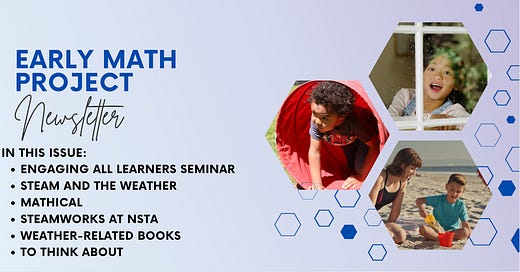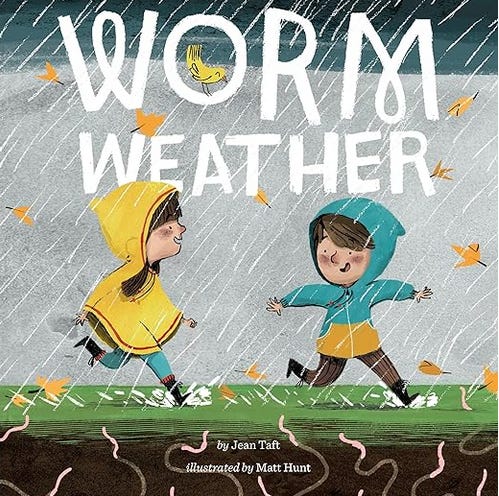Engaging All Learners - Spring Seminar
Sign up for this FREE virtual event which focuses on fostering student engagement and inclusive practices and strategies that promote children’s growth and development.
When: Wednesday, February 26, 2025 - 6:00 P.M. to 8:15 P.M. PACIFIC Time
All are invited. Please share.
Attendance certificates will be available.
Sponsored by Count Play Explore, an early math, science, and computer science initiative of the State of California led by the Fresno County Superintendent of Schools.
STEAM and the Weather
Math, Science, Computer Science and the Weather Go Together! Why is that?
Weather forecasts rely on observations, data collection, and mathematical calculations. Organizations that monitor and predict the weather, like the National Oceanic and Atmospheric Administration (NOAA), use supercomputers to track weather systems and atmospheric patterns to create weather models.
Children can use simple tools and technology to monitor temperature, air pressure, wind speed, and moisture to forecast the weather. Aspiring meteorologists might like to:
Count
Count clouds.
Count rain boots.
Count umbrellas.
Count the worms on a sidewalk after a rain.
Look at an outdoor thermometer and practice skip counting by ten.
Count the sunny days in a month and compare that total to the number of sunny days in other months.
Count a cricket’s chirps. Figure out what number + the number of times a cricket chirps in fifteen seconds = the temperature.
Measure
Measure the depth of puddles.
Compare the depth of puddles to the height of a pair of rain boots.
Find an earthworm after the rain. Carefully measure its length.
Create a simple rain gauge with a measurement scale using recycled materials.
Measure and keep a log of precipitation.
Compare the predicted precipitation levels with actual precipitation collected in a rain gauge.
Compare and Contrast
Create a picture of what the sky looks like on a sunny day. How do you dress and what do you do on a sunny day? Create a picture of what the sky looks like on a stormy day. How do you dress and what do you do on a stormy day?
Notice different types of clouds and use words to describe them. Describe the clouds’ shape, size, color, and location in the sky. How are they different? How are they the same?
Find out what type of weather is associated with fluffy looking clouds, wispy clouds, dark clouds, clouds that are high in the sky, clouds that touch the ground.
Learn the names of different types of clouds and what makes them unique. Tell someone what you learned about clouds.
Keep a cloud journal. Draw what you see and/or describe what you noticed. Find out why clouds provide important clues about the weather.
How are rain, sleet, hail, and snow similar? How are they different?
Keep a Weather Journal
Draw or take pictures of the daily weather and/or write descriptions of what you notice.
Observe the weather for a week, month, or season. Keep track of the temperature, humidity levels, wind speed, and precipitation.
Predict what the weather will be like tomorrow using the information you record in your journal.
Graph weather data
Create a pictograph to show the number of cloudy days in a week.
Represent the number of sunny and rainy days in a week or month with a bar graph.
Create a line graph to track the month’s daily high and low temperatures.
Label graphs so they are easy to understand. What is the graph data saying?
Explain the information represented on the graph and tell how the data was collected.
Investigate Weather Lore
Investigate weather related sayings. Discover the science behind the sayings. Here are a few to get you started.
Red sky in morning, sailors take warning.
Red sky at night, sailors delight.
Crickets will tell you the temperature if you count their chirps.
When birds fly low, expect rain will fall and winds will blow.
The higher the clouds, the better the weather.
When a circle forms around the moon, rain or snow will follow soon.
When dew is on the grass, rain will come to pass.
Can a cricket really tell the temperature? Can you really reliably predict the temperature based on cricket behavior? Not sure? find out!
Does the color of the sky predict sunny days or storms?
What other weather lore can you find?
Make observations after it has rained
Take a hike after it rains. What is different after a rain?
Notice and listen to the animals you see after a rain. Make a list and tally how many of each type you observe with your eyes or ears. Compare your rainy-day list with the animals you see on a sunny day. Do you notice any differences?
Some animals like rain. Others avoid it. Do you enjoy or dislike rain?
Make your own weather station
Use an outdoor thermometer and simple tools, like homemade rain gauges, wind socks, and a barometer to create a weather station. A rain gauge can be made from recycled objects. A DIY barometer, to measure air pressure, can be made with a jar, tape, drinking straw, balloon, and rubber band. There are simple directions for making weather tools on line.
Collect and interpret weather data.
Create your own daily weather forecast based on your own observations.
Research
Explore Dolbear’s Law. Learn when crickets chirp at faster rates and why this happens.
Investigate how animals like squirrels and ants react to weather changes.
Learn about Phenology, the study of how plants and animals change seasonally.
Mathical
Mathical is more than a book prize. Mathical hosts a free readathon for PreK-8th grade students. Teachers at accredited public, private, and charter schools who teach any subject for PreK to 8th grade students may participate. Teachers may join through June 30, 2025. Mathical has many great resources, including author visits, Spanish-language titles, and book guides. Mathical also creates a monthly mini-newsletter for participating teachers too.
Love a good math story? Sign up today!
STEAMWORKS at the National Science Teaching Association Conference
STEAMWORKS is going to the National Science Teaching Association (NSTA) Conference in Philadelphia! This conference is created by and for science educators to share best practices, strategies, and resources in science education.
STEAMWORKS is a series of picture books and board books about science, technology, engineering, arts, and math (STEAM) developed through a partnership between Count Play Explore and Charlesbridge.
If you’re attending NSTA, please stop by the Charlesbridge booth on Thursday, March 27th - Saturday, March 29th, to learn about this upcoming children’s series. You’ll be able to sign up for the STEAMWORKS series newsletter and have a chance to win copies of the STEAMWORKS books!
Weather-Related Books
Celebrate on rainy days with the book Worm Weather by Jean Taft.
Try this Worm Weather-related activity!
You may also enjoy these books with seasonal themes
Book Guide and Activities for The Last Marshmallow by Grace Lin
Book Guide and Activities for Tap the Magic Tree by Christie Matheson
Book Guide and Activities for Anno’s Counting Book by Mitsumasa Anno
To Think About
Watch the video short, Over the Rainbow (1 minute: 56 seconds).










